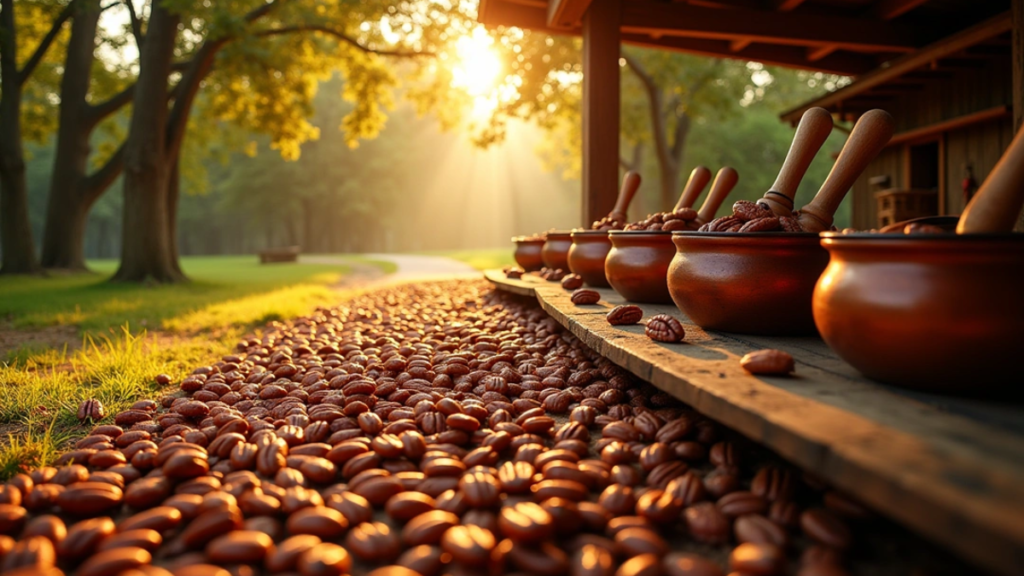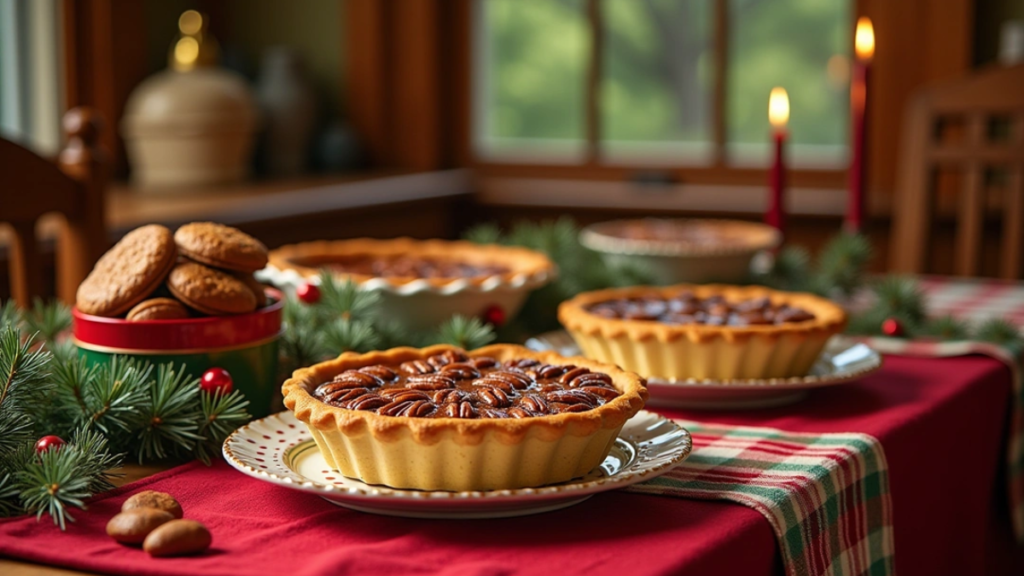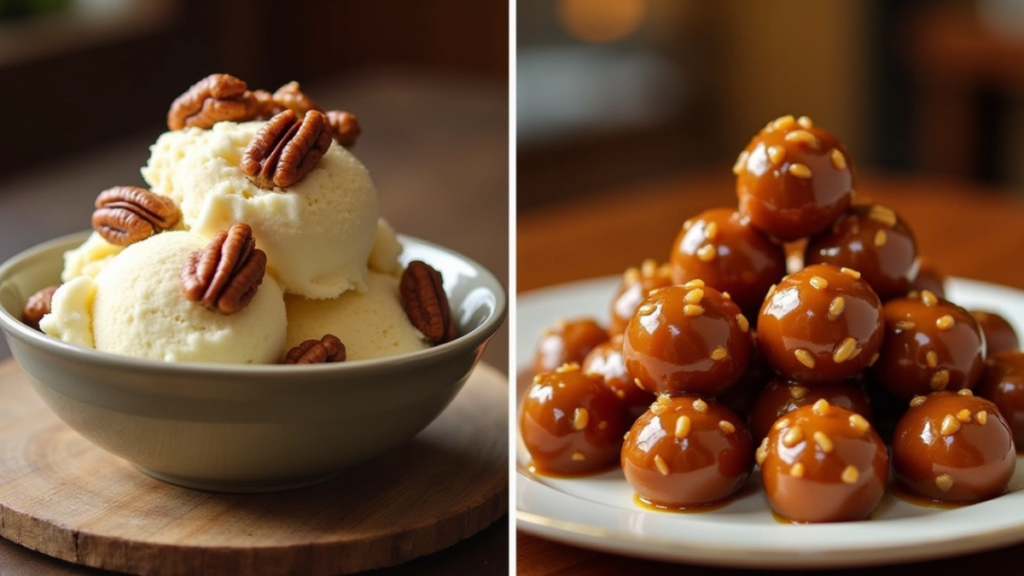Butter pecan and pecan praline are two beloved treats that celebrate the rich, nutty flavor of pecans, but they differ in preparation, taste, and uses. Butter pecan typically refers to a flavor profile found in ice creams, desserts, and baked goods, characterized by roasted pecans combined with butter, brown sugar, and vanilla for a creamy, slightly salty-sweet flavor. Pecan praline, on the other hand, originates as a confection, made by cooking pecans with sugar, cream, and butter to create a candy-like texture.
Understanding the differences between these two not only enhances your culinary knowledge but also helps you choose the right flavor for your recipe or treat. Whether you’re making ice cream, cookies, or candies, knowing the distinct characteristics of butter pecan and pecan praline ensures that each creation highlights their unique qualities. Dive deeper into these delightful flavors to elevate your desserts!

Origins and History
Butter Pecan
The history of butter pecan is tied to the evolution of American dessert culture, particularly ice cream. Pecans, native to North America, became a staple ingredient in Southern cooking due to their abundance and versatility. By the late 19th and early 20th centuries, as ice cream rose in popularity, flavors like butter pecan emerged as a luxurious choice. The flavor likely originated as a way to highlight the nutty richness of pecans by pairing them with butter and sugar, common pantry staples of the time.
Incorporating buttered, toasted pecans into creamy desserts created a balanced profile of sweetness and nuttiness, making butter pecan a favorite in the South and eventually across the U.S. Today, the flavor extends beyond ice cream, finding its way into cookies, cakes, and other confections, cementing its place as a timeless classic in American dessert traditions, check out our guide on how to make homemade butter pecan ice cream.
Pecan Praline
Pecan praline traces its origins to French cuisine, where the original praline was a sugar-coated almond confection created by the chef of César de Choiseul, Duke of Plessis-Praslin, in the 17th century. When French settlers brought the recipe to Louisiana, they adapted it using the locally abundant pecans and replaced some of the traditional ingredients with cream and butter. Want to try making these treats at home? Check out our recipe for Southern-style pecan pralines.
This Southern adaptation transformed pralines into the creamy, caramel-like candies known today. Over time, pecan pralines became a hallmark of Southern hospitality and tradition, often associated with New Orleans’ rich culinary heritage. Vendors in the French Quarter popularized the treat, making it a symbol of the region’s fusion of French and American cultures.
From its aristocratic French beginnings to its beloved status in the American South, pecan praline showcases the adaptability and cultural blending of culinary traditions, evolving into a treat that embodies Southern charm.

Ingredients and Preparation Methods
Butter Pecan
Key Ingredients:
The signature ingredients for butter pecan include pecans, butter, and vanilla extract. These three elements create a rich, nutty, and slightly sweet flavor profile that defines this classic taste. Depending on the recipe, sugar, salt, and heavy cream may also be used to enhance the flavor, especially in ice cream or baked goods.
Preparation:
- Toasting Pecans in Butter:
Toasting is a key step in preparing butter pecan. Fresh pecans are sautéed in melted butter until they turn golden brown and release their aromatic oils. This process enhances the pecans’ natural nuttiness and infuses them with a buttery richness. A pinch of salt may be added to balance the sweetness and bring out the flavor. - Incorporation into Desserts:
The toasted pecans are then folded into various desserts. In butter pecan ice cream, the pecans are added to a creamy vanilla custard base, which is churned to create a smooth, luxurious texture. For baked goods like cookies or cakes, the pecans may be mixed into the batter or sprinkled on top for added crunch and flavor. The result is a comforting, nostalgic dessert with a perfect balance of creamy sweetness and nutty depth.
To learn more about perfecting these desserts, see our tips on toasting pecans for baking.
Pecan Praline
Key Ingredients:
Pecan praline is built on a foundation of pecans, caramelized sugar, butter, and cream. These ingredients work together to create a rich, candy-like texture and a flavor that is sweet, buttery, and nutty. Some recipes include vanilla extract or a pinch of salt to enhance the taste.
Preparation:
- Creating the Candy Mixture:
To prepare pecan pralines, sugar (often brown or granulated) is combined with butter and heavy cream in a saucepan. The mixture is heated gently, stirring constantly, until the sugar dissolves and the liquid reaches a caramel-like consistency. Pecans are then stirred into the hot mixture, ensuring they are evenly coated with the caramel. - Cooling into Patty Shapes:
The caramel-pecan mixture is spooned onto a parchment-lined surface in small mounds or patties. As the mixture cools, it solidifies into firm, glossy candies with a soft, fudgy texture. This process requires precision to prevent the caramel from hardening too quickly or becoming grainy.

Flavor Profiles and Textures
Butter Pecan
Flavor:
The flavor of butter pecan is a harmonious balance of sweet, buttery, and nutty notes. The butter-toasted pecans introduce a rich nuttiness, while the butter itself adds a luxurious, slightly savory depth that complements the sweetness. Vanilla extract often enhances the overall flavor, lending a warm and aromatic undertone. Unlike overly sweet desserts, butter pecan relies on the subtle interplay of its ingredients, making it a favorite for those who enjoy desserts that are rich yet not cloyingly sweet.
Texture:
The texture of butter pecan desserts varies depending on the preparation but generally features a creamy base punctuated by crunchy pecan pieces. In ice cream, the smooth, velvety custard contrasts beautifully with the toasted pecans, offering a satisfying crunch in each bite. In baked goods, the pecans provide a delightful texture that stands out against the soft crumb of cookies or cakes. This combination of creaminess and crunch is central to the appeal of butter pecan, making it both comforting and indulgent.
Pecan Praline
Flavor:
Pecan praline is characterized by its bold sweetness and rich, nutty flavor. The caramelized sugar provides an intense, almost toffee-like sweetness, while the butter and cream add a creamy, melt-in-your-mouth richness. The pecans themselves contribute a distinct nuttiness that balances the sugar’s intensity, creating a flavor profile that is deeply satisfying. In contrast to butter pecan, pecan praline leans more heavily on the sweetness, making it a quintessential Southern candy treat.
Texture:
The texture of pecan praline can vary depending on the recipe and cooling process, but it typically falls into the chewy or fudgy category. When properly prepared, pralines have a soft yet slightly firm consistency that melts in your mouth while maintaining a delicate crumb. The pecans embedded within the candy add a pleasant crunch, creating a dynamic textural experience. Some variations might be slightly grainy due to the crystallization of sugar, which is considered a hallmark of traditional pralines.
Comparison of Texture and Flavor:
While both butter pecan and pecan praline celebrate the flavor of pecans, their textures and flavor profiles make them unique. Butter pecan focuses on a balanced sweetness with creamy and crunchy elements, ideal for ice creams and baked goods. Pecan praline, on the other hand, emphasizes sweetness and richness, offering a chewy candy texture that makes it a perfect standalone treat. Both showcase the versatility of pecans in creating irresistible desserts.

Culinary Uses and Variations
Butter Pecan
Common Applications:
Butter pecan is most famously associated with ice cream, where its creamy base is infused with the nutty, buttery richness of toasted pecans. The flavor’s popularity extends to baked goods such as cookies, cakes, and pies, where butter pecan is used to elevate traditional recipes. Butter pecan cookies, for instance, combine buttery dough with crunchy pecan pieces, while butter pecan cakes layer moist cake with the iconic flavor of roasted pecans and butter. Additionally, butter pecan makes its way into frostings, fudge, and even savory dishes like pecan-crusted proteins, demonstrating its versatility.
Variations:
Many variations of butter pecan incorporate additional elements to enhance its complexity. Caramel ribbons are a popular addition in butter pecan ice cream, introducing a layer of gooey sweetness that complements the buttery base. Similarly, butterscotch swirls provide a deeper, more toffee-like flavor. In baked goods, chocolate chips or white chocolate may be included for a touch of indulgence, while spices such as cinnamon or nutmeg are sometimes added for warmth. For a seasonal twist, some recipes integrate pumpkin or sweet potato puree, creating a butter pecan-inspired holiday treat.
For more inspiration, browse our list of delicious pecan desserts.
Pecan Praline
Common Applications:
Pecan praline is primarily enjoyed as a standalone candy, celebrated for its rich, caramelized flavor and satisfying chew. However, its uses extend beyond candy, as pralines are often crumbled or crushed to serve as a topping for desserts. They pair beautifully with vanilla ice cream, adding texture and a sweet crunch. Pecan praline is also a favorite addition to cheesecakes, bread puddings, and pecan pies, where it brings an extra layer of sweetness and flavor. In some recipes, praline is blended into frostings or fillings, offering a luxurious, candy-like element to cakes and pastries.
Variations:
A notable variation is praline pecans, which feature individual pecan halves coated in the signature praline mixture. These sweet, crunchy nuts are perfect as snacks, garnishes for salads, or toppings for sweet potato casseroles. Another variation is praline sauce, made by melting praline candy or preparing a caramel-like syrup infused with pecans.
Modern takes on pecan praline may include additions like chocolate or spices such as cayenne for a spicy-sweet kick, appealing to contemporary tastes.
Culinary Uses and Variations
Butter Pecan
Common Applications:
Butter pecan cookies, for instance, combine buttery dough with crunchy pecan pieces, while butter pecan cakes layer moist cake with the iconic flavor of roasted pecans and butter. Additionally, butter pecan makes its way into frostings, fudge, and even savory dishes like pecan-crusted proteins, demonstrating its versatility.
Variations:
Many variations of butter pecan incorporate additional elements to enhance its complexity. Caramel ribbons are a popular addition in butter pecan ice cream, introducing a layer of gooey sweetness that complements the buttery base. Similarly, butterscotch swirls provide a deeper, more toffee-like flavor. For a seasonal twist, some recipes integrate pumpkin or sweet potato puree, creating a butter pecan-inspired holiday treat.
Pecan Praline
Common Applications:
They pair beautifully with vanilla ice cream, adding texture and a sweet crunch. Pecan praline is also a favorite addition to cheesecakes, bread puddings, and pecan pies, where it brings an extra layer of sweetness and flavor.
Variations:
A notable variation is praline pecans, which feature individual pecan halves coated in the signature praline mixture. These sweet, crunchy nuts are perfect as snacks, garnishes for salads, or toppings for sweet potato casseroles. Another variation is praline sauce, made by melting praline candy or preparing a caramel-like syrup infused with pecans.
Modern takes on pecan praline may include additions like chocolate or spices such as cayenne for a spicy-sweet kick, appealing to contemporary tastes.
For more inspiration, browse our list of delicious pecan desserts.
Cultural Significance and Popularity
Role in Southern U.S. Cuisine:
The pecan tree, native to North America, thrives in the Southern states, making pecans a cornerstone of Southern culinary traditions. Butter pecan, with its rich, creamy flavor, is a favorite in Southern desserts like pies, cakes, and especially ice cream, which is a staple at family gatherings and community events. Pecan praline, on the other hand, is a hallmark of Southern confectionery, originating in Louisiana and symbolizing the French influence on the region’s cooking.
Association with Holidays and Regional Traditions:
Butter pecan desserts, from cakes to cookies, often grace tables during Thanksgiving and Christmas, highlighting the festive flavors of the season. Pecan pralines, often handmade, are a traditional holiday gift and a treat at Southern weddings, showcasing their role in commemorating special occasions. In New Orleans, pralines are a symbol of the city’s culinary heritage, sold in markets and celebrated as a sweet souvenir. These treats not only reflect the South’s love for pecans but also its deep-rooted traditions of creating and sharing food that brings people together.
Conclusion
Butter pecan and pecan praline both celebrate the rich, nutty flavor of pecans but in distinct ways. Butter pecan offers a creamy, balanced sweetness with toasted pecans, perfect for ice creams and baked goods, while pecan praline delivers an intensely sweet, candy-like experience with caramelized sugar and a chewy texture. Each has its unique place in Southern cuisine, embodying warmth and tradition. Whether you prefer the subtle elegance of butter pecan or the indulgent richness of pecan praline, both are worth exploring for their delightful flavors and versatility in desserts. Treat yourself to these timeless classics!
Frequently Asked Questions (FAQs)
Q: What’s the difference between butter pecan and pecan praline?
A: Butter pecan and pecan praline differ in preparation, flavor, and texture. Butter pecan is a flavor profile, commonly found in ice creams and baked goods, featuring toasted pecans, butter, and a creamy or buttery base. Butter pecan leans toward a balanced, creamy sweetness, while pecan praline is sweeter and richer.
Q: Is butter pecan just vanilla with pecans?
A: No, butter pecan is distinct from vanilla ice cream with pecans. While both might include pecans, butter pecan involves toasting the nuts in butter, which imparts a rich, nutty, and slightly savory flavor to the dessert. Additionally, butter pecan typically includes a buttery base and may incorporate subtle hints of brown sugar, differentiating it from plain vanilla.
Q: What flavor is praline pecan?
A: Praline pecan has a sweet, caramel-like flavor from the caramelized sugar used in its preparation. It’s rich and buttery, with a nutty undertone from the pecans.
Q: What is the difference between pecan candy and pecan praline?
Pecan candy, in a broader sense, can refer to any sweet treat featuring pecans, such as candied pecans (sugar-coated whole nuts), pecan brittle (a hard candy with pecans), or praline sauce. Pralines are a subset of pecan candies, known for their unique creamy texture and caramel flavor.

